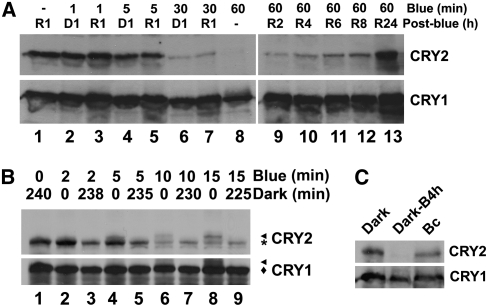Figure 4.
Continuous Blue Light and CRY2 Phosphorylation Is Required for CRY2 Degradation.
(A) Immunoblots showing the level of CRY2 in etiolated seedlings exposed to blue light for different durations and then transferred to red light or dark (post-blue) for 1 h (lanes 1 to 8) or the level of CRY2 in etiolated seedlings exposed to blue light for 60 min (blue) and then transferred to red light for different durations (lanes 9 to 13).
(B) Immunoblot showing changes in the levels of phosphorylated CRY2 and unphosphorylated CRY2 in etiolated seedlings exposed to blue light followed by a posttreatment in the dark. Five-day-old etiolated wild-type seedlings were exposed to blue light (15 μmol m−2 s−1) for the durations indicated (blue). Samples were either analyzed immediately after blue light exposure (lanes 2, 4, 6, and 8) or analyzed after a dark treatment for the durations indicated (lanes 3, 5, 7, and 9). Arrowhead and asterisk (or diamond) indicate phosphorylated and unphosphorylated CRY2 (or CRY1), respectively.
(C) Immunoblot showing CRY2 in 5-d-old etiolated seedlings (dark) exposed to blue light for 4 h (20 μmol m−2 s−1; Dark-B4 h) or 5-d-old seedlings germinated and grown in continuous blue light (20 μmol m−2 s−1; Bc). Similar amounts of total protein from different samples were loaded as shown by the similar level of CRY1 (bottom).

